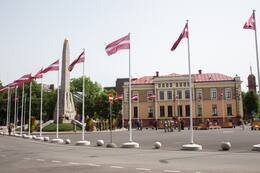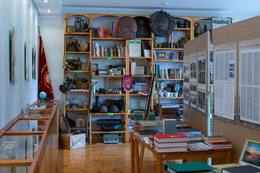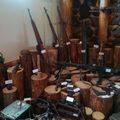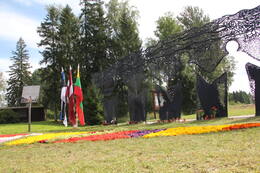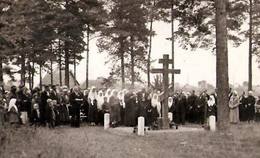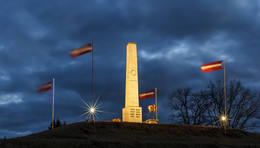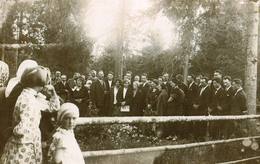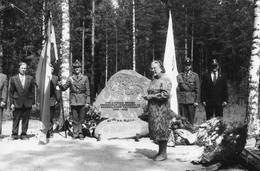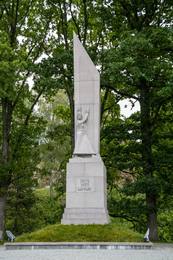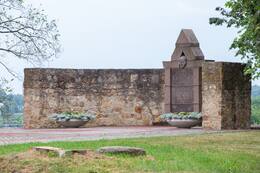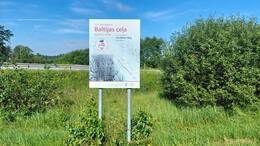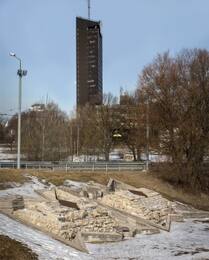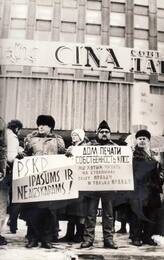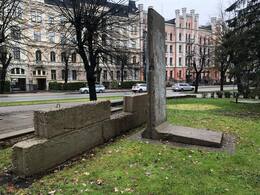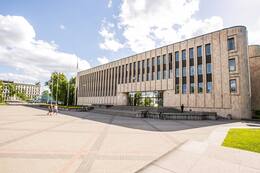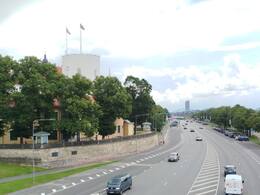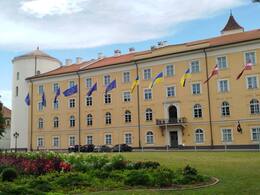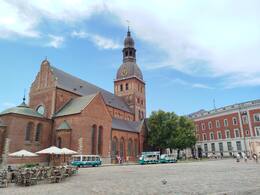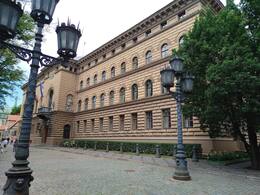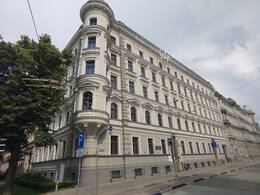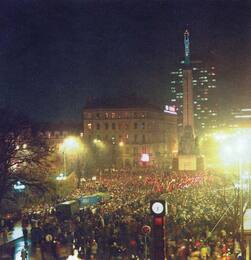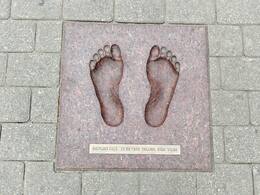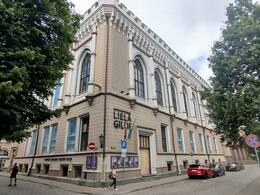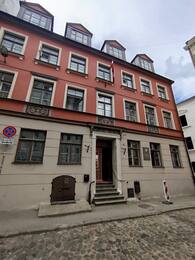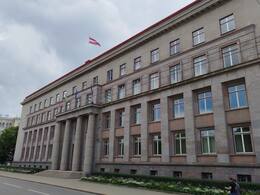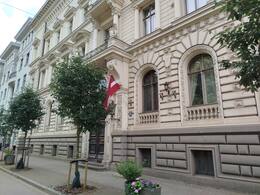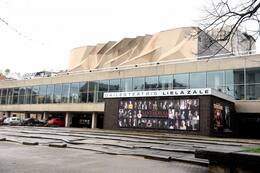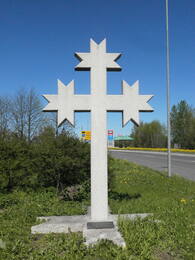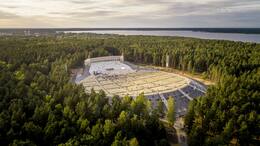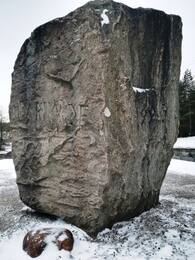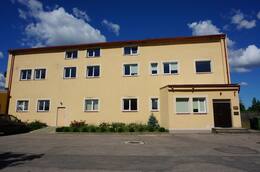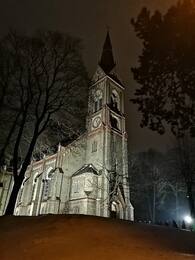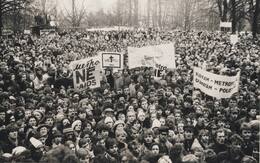Trečiasis pabudimas arba Dainuojamoji revoliucija (1987–1991)
Atkurta Nepriklausomybė, IV Sovietų okupacija
Trečiasis atgimimas arba Dainuotoji revoliucija – socialinis judėjimas, atvedęs prie Latvijos nepriklausomybės atkūrimo 1991 m.
Dainuotoji revoliucija (Latvijoje taip pat vadinama Trečiajais atgimimu) buvo Baltijos šalių (Latvijos, Lietuvos, Estijos) istorijos laikotarpis nuo 1986 iki 1991 metų, pasibaigęs visišku valstybinės nepriklausomybės atkūrimu visose trijose šalyse. Nacionalinio atgimimo judėjimo pradžioje, 1987 m. vasarą ir rudenį, vyko visuomenės dalies, nepatenkintos SSRS totalitarizmu Latvijoje, vieši protestai, kurie sutapo su reikšmingomis Latvijos istorijos datomis. 1987 m. birželio 14 d. visuomeninis judėjimas „Helsinkis-86“ surengė gėlių padėjimą prie Laisvės paminklo Rygoje 1941 m. birželio trėmimų aukoms atminti, kurį valdžia bandė sutrikdyti dviračių varžybomis. Latvijos komunistų partijos Centro komitetas ir jam paklusni valdžia taip pat buvo prieš populiarius renginius prie Laisvės paminklo 1987 m. rugpjūčio 23 d. ir lapkričio 18 d.
1988 m. birželio 1 ir 2 d. Rygoje įvyko Kūrybinių sąjungų plenumas, kuriame laikraščio „Cīņa“ ir televizijos politinių įvykių komentatorius Mavriks Vulfsons pirmasis atvirai perskaitė 1939 m. Molotovo-Ribentropo pakto slaptuosius protokolus ir paviešino Latvijos okupacijos faktą. Birželio 14 d. Politinio švietimo namuose įvyko viešas mitingas ir eitynės į Brolių kapines, kurių priešakyje pirmą kartą po Antrojo pasaulinio karo per Rygą buvo nešama raudonai baltai raudona vėliava. Liepos 10–17 d. Rygoje ir kitose Latvijos vietose, vyraujant patriotinei nuotaikai, vyko folkloro festivalis BALTICA. Spalio 7 d. Mežaparke vyko Liaudies manifestacija už Latvijos valstybės simbolikos atkūrimą. 1988 m. spalio 8 ir 9 d. Politinio švietimo namuose įvyko pirmasis Latvijos liaudies fronto suvažiavimas, kuriame pirmuoju LTF vadovu buvo išrinktas publicistas Dainis Īvāns.
1989 m. gegužės 31 d. LTF valdyba paragino surengti diskusiją dėl visiško Latvijos nepriklausomybės atkūrimo. Liepos 28 d. Latvijos SSR Aukščiausioji Taryba priėmė Deklaraciją dėl Latvijos SSR suvereniteto, kuria Latvijos SSR įstatymai buvo paskelbti viršesniais už SSRS įstatymus. Rugpjūčio 23 d. įvyko liaudies akcija „Baltijos kelias“ prieš Ribentropo-Molotovo paktą ir jo pasekmes, kai apie du milijonai žmonių, susikibę rankomis, sudarė maždaug 670 km ilgio gyvąją grandinę, kuri truko mažiausiai 15 minučių ir jungė Baltijos valstybių sostines. 1989 m. spalio 7 ir 8 d. įvyko II LTF suvažiavimas, kuriame buvo paskelbtas kursas Latvijos nepriklausomybės atkūrimo link.
1990 m. kovo 18 d. įvyko Latvijos SSR Aukščiausiosios Tarybos rinkimai, kuriuose didžiausią paramą gavo Latvijos socialistų revoliucijos partijos iškelti kandidatai. 1990 m. gegužės 4 d. Latvijos Aukščiausioji Taryba priėmė deklaraciją „Dėl Latvijos Respublikos nepriklausomybės atkūrimo“.
Dėl 1991 m. sausio 13 d. įvykdytų civilių šaudymų prie televizijos pastato Vilniuje, Daugmalėje įvyko Latvijos nacionalinė demonstracija, kurioje dalyvavo apie 500 000 žmonių su Latvijos nacionalinėmis vėliavomis. Nuo sausio 13 d. Rygoje keliose vietose iš gelžbetonio blokų buvo statomos barikados, taip pradedant barikadų laikotarpį Latvijoje. Barikadų laikotarpis yra istorinis 1990 m. gegužės 4 d. atkurtos Latvijos Respublikos gynybos priemonių, kurios buvo organizuojamos Rygoje ir kituose Latvijos miestuose nuo 1991 m. sausio 13 iki 27 d., pavadinimas. 1991 m. rugpjūčio 19–21 d. Maskvoje valdžią perėmė vadinamasis Valstybinis nepaprastosios padėties komitetas. Rugpjūčio 21 d. OMON daliniai Senojoje Rygoje užpuolė barikadas prie Saeimos rūmų, Latvijos Respublikos Aukščiausioji Taryba priėmė pareiškimą dėl visiško Latvijos Respublikos Konstitucijos atkūrimo, užbaigdama 1990 m. gegužės 4 d. postuluotą pereinamąją padėtį.
Daugiau informacijos šaltinių
Guntis Šmidhensas. Dainuojamoji revoliucija. Nacionalinė enciklopedija: https://enciklopedija.lv/skirklis/101078-Dziesmot%C4%81-revol%C5%ABcija
Dainuojamoji revoliucija. Vikipedija. https://lv.wikipedia.org/wiki/Dziesmot%C4%81_revol%C5%ABcija
Susijusi laiko juosta
Susijusios vietos
Pergalės paminklas Cėsyse
Pergalės paminklas latviams ir estams, žuvusiems Cėsių mūšiuose, yra Cėsių mieste, Vienybės aikštėje. Pagerbiant 1919 m. Cėsių mūšių dalyvius, 1924 m. birželio 22 d., už gyventojų paaukotas lėšas, pagal architekto Paulo Kundzinio eskizą buvo padėtas pirmasis Pergalės paminklo akmuo. Sovietų okupacijos metu, 1951 m. kovo 25 d. naktį, paminklas buvo susprogdintas ir visiškai nugriautas. Nuo 1959 iki 1990 m. buvusioje Pergalės (Vienybės) aikštėje stovėjo skulptoriaus Kārlio Jansonso sukurtas Lenino paminklas. 1997 m. Cėsių rajono tarybos pirmininkas Māris Niklass sugebėjo įtraukti Estijos valstybės institucijas į paminklo restauravimą. Paminklo statybai reikalinga medžiaga – Saremos dolomitas – buvo gauta dovanų iš Estijos. 1998 m. birželio 22 d., minint 79-ąsias Cėsių mūšių metines, Vienybės aikštėje buvo padėtas pirmasis restauruojamo paminklo akmuo. Atkurto Pergalės paminklo atidengimo ceremonija Cėsyse įvyko 1998 m. lapkričio 15 d. (autorius: architektas Imants Timermanis). Informacijos apie Pergalės paminklą galima rasti Cėsių istorijos ir meno muziejaus ekspozicijoje „Cėsys ir Latvijos nepriklausomybės karas“, esančioje Naujojoje pilyje.
Vaidavos parapijos kraštotyros nuolatinė ekspozicija
Įsikūręs Vaidavos kultūros ir amatų centre.
Eksponuojama paroda, skirta 1949 m. trėmimų atminimui, taip pat Vajdaviečių dalyvavimui Rygos barikadose 1991 m. sausį. Parodoje taip pat eksponuojami pasaulinių karų įrodymai (daugiausia spausdinta medžiaga).
Gamtos ir istorijos objektai, dvarai, švietimo istorija, kultūra, žymūs žmonės, kolūkio laikų medžiaga, namų apyvokos rakandai, banknotai, laikraščiai, žurnalai apie Vaidavos parapiją.
Rendos nacionalinio pasipriešinimo judėjimo muziejus
Muziejus yra įsikūręs už kelių kilometrų nuo Rendos parapijos centro. Parodoje pasakojama apie 50 metų trukusį pasipriešinimo judėjimą Latvijoje: pasipriešinimą pirmajai sovietų okupacijai, pasipriešinimą nacistinės Vokietijos okupacijai ir ginkluotą bei nesmurtinį pasipriešinimą sovietų okupacijai. Paroda įsikūrusi dviejuose pastatuose. Pirmajame pastate saugomi pirmosios sovietų ir vokiečių okupacijos įrodymai. Parodoje eksponuojamas restauruotas tvarto pastatas, kuriame dėmesys sutelktas į Nacionalinį partizaninį karą. Tarp dviejų pastatų yra autentiško išplanavimo bunkeris ir kareivių naudoti apkasai. Netoli muziejaus Rendoje esantys kasinėjimai, blindažo aikštelė ir kliūčių ruožas tarnauja kaip jaunimo sargybinių ir visų susidomėjusiųjų treniruočių aikštelė. Apsilankymus būtina užsisakyti iš anksto.
Vienas didžiausių nacionalinių partizanų mūšių, vadinamas Āpūzniekų mūšiu, įvyko 1946 m. sausį netoli čia. Mūšyje Kabilės nacionalinis partizanų būrys nugalėjo daug didesnes okupacinės valdžios pajėgas. Mūšio vietoje, kurioje yra informaciniai stendai, dabar įrengta poilsio aikštelė.
Skulptūra, skirta Baltijos keliui
Įsikūręs Ungurinių-Lilių pasienio punkte tarp Latvijos ir Estijos.
2009 m. pavasarį Ķonių parapijos savivaldybė, kurios teritorija ribojasi su Estija, bendradarbiaudama su metalo menininku Andriu Dukuru sukūrė skulptūrą, skirtą „Baltijos kelio“ dvidešimtmečiui.
Devynių metrų ilgio ir dviejų su puse metro aukščio skulptūra su žmonių siluetais, kur galima atsistoti ir laikytis už rankų tuščiose žmonių siluetų vietose. Skulptūros idėja leidžia praplėsti laiko dimensiją ir ne tik prisiminti 1989 m. gyvų žmonių grandinę, bet ir suteikia galimybę bet kuriuo metu kartu su skulptūra tapti „Baltijos kelio“ dalimi.
Vaizdo įrašas apie skulptūros sukūrimą.
Baltijos kelias buvo unikali akcija ne tik Baltijos šalyse, bet ir Europos bei net pasaulio mastu. Dar niekada trijų šalių gyventojai nebuvo susivieniję į gyvą dalyvių grandinę, jungiančią šalių sostines – Vilnių, Rygą ir Taliną. Istorinis įvykis įvyko 1989 m. rugpjūčio 23 d. vakarą, jis suvienijo apie 2 milijonus žmonių. Jo tikslas buvo atkreipti dėmesį ir prisiminti 50 metų senumo įvykius – Ribentropo-Molotovo pakto sudarymą. Dėl to dvi tuometinės supervalstybės – Vokietija ir SSRS – iki kito pasaulinio karo perskirstė įtakos sferas Europoje, tačiau Baltijos valstybės prarado nepriklausomybę.
Maždaug 600 km ilgio dalyvių grandinė Latvijoje žymėjo Baltijos kelią nuo Bauskės iki Rygos, toliau iki Siguldos, Cėsių, Valmieros ir Rūjienos.
Paminklas sentikių kariams, žuvusiems už Latvijos išlaisvinimą
Įsikūręs Jėkabpilio miesto kapinėse.
Galima apžiūrėti sentikių bendruomenės pastatytą paminklą kariams – sentikiams, žuvusiems už Latvijos išlaisvinimą 1918–1919 m.
Sentikių bendruomenei priklausė kelios šeimos, kurių atstovai dalyvavo 1918–1919 m. mūšiuose, kai buvo svarstomas Latvijos nepriklausomybės klausimas. Po Laisvės kovų šiems kariams iš nemokamos žemės fondo buvo skirti žemės sklypai. Pavyzdžiui, Latvijos armijos karininkui Nikolajui Lebedevui. 1935 m., sentikių bendruomenės pirmininkės, mokytojos Tarasijos Makarovos (1880–1953), siūlymu, buvo nuspręsta pastatyti paminklą kovotojams už Latvijos nepriklausomybę. Jėkabpilio miesto kapinėse, išvalytoje ir žvyruotoje aikštelėje, kurią riboja baltai nubaltinti stulpai, po pušimi buvo pastatytas beveik trijų metrų aukščio ąžuolinis kryžius. Sentikių staliai apdirbo medieną ir sukūrė įspūdingą aštuonkampį kryžių. Laikantis tradicijos, ant atskiros ąžuolinės lentelės kryžiaus papėdėje buvo sukurtas aiškinamasis užrašas. Jėkabpilyje, V. Lukomskio baldų dirbtuvėse, rusų kalba buvo iškaltas užrašas: „Kareiviams – sentikiams, žuvusiems už Latvijos išlaisvinimą. Dieve, suteik jiems amžiną atminimą!“ Iš pradžių minėto kryžiaus apylinkėse nebuvo laidojimo vietų – tik pušynas. 1950-aisiais kryžius buvo pasenęs. Tuometinis sentikių bendruomenės pirmininkas Vasilijus Jakovlevičius Fedotovas 1960-ųjų viduryje gavo leidimą atkurti memorialinę vietą, tik su sąlyga, kad paminklas nebus kryžiaus formos ir su užrašu: „Už Tėvynės išlaisvinimą“.
Paminklo restauravimas buvo patikėtas A. Blumbergui. Jis nupoliravo didelį rudą akmeninį luitą stačiakampės memorialinės stelos pavidalu ir ant jo priekinės sienos išraižė aštuoniakampį kryžių bei ąžuolo šakas. Po žodžiais „Amžina žuvusių karių atmintis už Tėvynės išlaisvinimą“ daug mažesnėmis raidėmis buvo nupoliruotas užrašas „Jekabpilio sentikių bendruomenė“. Paminklas buvo pastatytas ant tvirto betoninio pagrindo. Savo ruožtu ankstesnė ąžuolinė lenta su užrašu buvo apsaugota, pastatant ją bažnyčioje.
Kadangi Trečiojo atgimimo pradžioje Jėkabpilyje nebuvo išlikęs joks kitas su Latvijos valstybės paskelbimu susijęs paminklas. Todėl 1988 m. lapkričio 18 d. jekabpiliečiai sentikių kapinėse prie paminklo Latvijos Nepriklausomybės kare žuvusiems kariams surengė atminimo minutę su gėlėmis ir žvakėmis. Netrukus restauruota ąžuolinė lenta vėl buvo pastatyta prie memorialinio stulpo papėdės. Netrukus ąžuolinė lenta buvo pakeista marmurine su identiška originalaus užrašo reprodukcija. 2013 m., Belovodije asociacijos iniciatyva ir projektu, paminklas buvo restauruotas ir išvalytas.
Paminklas 7-ojo Siguldos pėstininkų pulko kariams, žuvusiems Latvijos Nepriklausomybės kare
Įsikūręs Alūksnės ežero pakrantėje, Pskevo (Kolbergo) gatvės pusėje.
1923 metų birželio 22 dieną Latvijos prezidentas Jānis Čakste atidengė paminklą žuvusiems 7-ojo Siguldos pėstininkų pulko kariams. Paminklą sukūrė dailininkas Jūlijs Miesnieks.
Pulko kariai taip pat gerino ir tvarkė paminklo aplinką. Kareiviai prie paminklo rinkosi pulko metinių minėjimo išvakarėse, kai uždegdavo šventąją ugnį, taip pat pulko metinių dieną po parado ir užtarimo Garnizono kapinėse.
1940/1941 m. bolševikai pašalino ir sunaikino lentą, tačiau pats paminklas buvo nugriautas 1953 m., o jo akmenys įmūryti į kareivinių pastato kampinius pamatus.
Prasidėjus Atbudimui, 1989 m. rudenį buvo sutvarkyta teritorija aplink sunaikintą paminklą, kuris tuo metu dar buvo SSRS okupacinių kariuomenės teritorijoje. Lapkričio 11 d. buvusioje paminklo vietoje buvo atidengtas laikinas granito memorialas su išgraviruotu tekstu: „7-ojo Siguldos pėstininkų pulko paminklas šioje vietoje bus atkurtas 1989 m. lapkričio 11 d.“
Alūksnės brolių kapinių komiteto vadovo U. Veldre iniciatyva buvo pradėti paminklo restauravimo darbai, o restauruotas paminklas atidengtas 2009 m. spalio 16 d.
Skirtingai nuo originalaus paminklo, ant obelisko vietoj pulko krūtinės šarvų buvo sukurtas kryžius. Abu paminklo reljefus nukalė skulptorius Ainārs Zelčs. Restauruotam paminklui panaudotos tiek 22 originalių obelisko blokų dalys, rastos Nacionalinių ginkluotųjų pajėgų pėstininkų mokyklos teritorijoje, tiek naujai pagaminti blokai.
2019 m. birželio 20 d., minint 7-ojo Siguldos pėstininkų pulko šimtmečio jubiliejų, paminklo kalnelio papėdėje buvo atidengta pulko paminklo atminimo vieta ir granito atminimo lenta žuvusiems dalinio kariams, ant kurios išgraviruotas tekstas: „Jūsų stipri dvasia visada su mumis...“. Atminimo vieta pastatyta Nacionalinių ginkluotųjų pajėgų Pėstininkų mokyklos personalo paaukotomis lėšomis.
Paminklas žuvusiems Latvijos legiono kariams ir nacionaliniams partizanams
Įsikūręs Lubanos naujosiose kapinėse Indrani parapijoje.
Apžiūrėti galima žuvusių Latvijos legiono karių ir nacionalinių partizanų atminimo vietą.
Memorialas atidengtas 1992 m. liepos 25 d. Atminimo akmenį sukūrė Andris Briezis.
Prasidėjus Atbudimui, 1990 m. spalį žmogaus teisių grupės „Helsinkis 86“ narys Kārlis Doropolskis gavo valdžios leidimą pradėti perlaidoti 1944 m. vasarą Lubanoje žuvusius ir palaidotus Latvijos legionierius, taip pat vėlesniuose mūšiuose su sovietų okupacine kariuomene ir saugumo institucijomis žuvusius nacionalinius partizanus bendruose masiniuose kapuose, kurie buvo įrengti naujose Lubanos kapinėse. Iš viso masiniuose kapuose buvo palaidoti 26 žuvę legionieriai ir nacionaliniai partizanai.
Laisvės paminklas Raunoje
Skulptoriaus Kārlio Zemdegso sukurtas paminklas skirtas Raunos parapijos narių, žuvusių Pirmajame pasauliniame kare ir Nepriklausomybės kovose, atminimui.
Kaip vienas iš neįgyvendintų Rygos Laisvės paminklo projekto variantų, jis buvo atidengtas 1933 m. rugpjūčio 20 d. Atidarymo renginyje dalyvavo trečiasis Latvijos Respublikos prezidentas Albertas Kviesis.
Originalus paminklo pavadinimas buvo „ES DŪR“ – šūkis – ietis virsta kokle, o žmones išgelbėja dainos dvasia. Paminklo pagrindą puošia Baumanių Kārlio sukurtos giesmės „Dieve, laimink Latviją“ žodžiai.
Prieš paminklo atidengimą 1933 m., Raunės gyventojai, tvarkydami paminklą, pasodino ąžuolų alėją ir po kiekvienu ąžuolu pastatė kapsulę su žuvusio kario vardu. Vėliau, 1937 m., kovotojų vardai buvo išgraviruoti ant baltos marmurinės plokštės, kuri yra bažnyčioje.
Komunistinės okupacijos metu užrašas „Dieve, laimink Latviją“ buvo nuimtas nuo postamento. Jis buvo atstatytas 1989 m. birželį, prasidėjus Atgimimui.
Paminklas Nepriklausomybės kare žuvusiems kariams
Įsikūręs Valkoje, Varonių gatvėje, šalia Miško kapinių.
Galima pamatyti paminklą 30-iai 1-ojo (4-ojo) Valmieros pėstininkų pulko karių, žuvusių Latvijos Nepriklausomybės kare.
Paminklas atidengtas 1922 m. spalio 1 d. Jį sudaro iš vietinio rausvo granito išdrožta senovės latvių kario („Protėvio“) figūra, pastatyta ant dviejų dalių pilko granito pjedestalo. Paminklo projektą pasirinko skulptorius Emīls Melders (Miller). Kartu su Meldersu paminklo drožyboje dalyvavo ir skulptorius Vilhelms Treijs.
Tai pirmasis profesionalaus skulptoriaus sukurtas Latvijos Nepriklausomybės karo paminklas, taip pat vienintelis tarpukariu sukurtas modernistiniu stiliumi, naudojant kubizmo elementus.
Pakartotinės komunistinės okupacijos metu 1951 m. paminklinė skulptūra buvo nuversta, iš dalies apgadinta ir užkasta. Kapinės taip pat buvo sulygintos.
1988 m., artėjant skulptoriaus E. Melderso (1889–1979) šimtmečiui, buvo pradėtas jo darbų tyrimas.
Atkurtos brolių kapinės kartu su restauruotu paminklu buvo atidarytos 1990 m. lapkričio 11 d.
2017 m. brolių kapinėse buvo įrengtos aštuonios atminimo stelos su Valku susijusiems Lačplėsio karo ordino riteriams. Jos yra abiejose paminklo pusėse – po keturias stelas kiekvienoje pusėje.
Paminklas žuvusiems už Tėvynę 1918–1920 m.
Įsikūręs Rīgas gatvės pusėje, priešais Krustpilio pilį.
Jėkabpilyje, dešiniajame Dauguvos krante, buvo pastatytas paminklas „Žuvusiems už Tėvynę 1918–1920 m.“, o pasiūlymą pastatyti paminklą Nepriklausomybės kare žuvusiems kariams 1923 m. birželio 12 d. pateikė Latvijos brolių kapinių komiteto Krustpilio skyrius. Paminklui sukurti Krustpilio parapijos valdyba 1923 m. lapkričio 12 d. perdavė Brolių kapinių komitetui akmeninę caro Aleksandro II paminklo dalį prie parapijos valdybos pastato, kur paminklas buvo pastatytas baudžiavos panaikinimo garbei. Latvijos vidaus reikalų ministerija leido Krustpilio Brolių kapinių komiteto Krustpilio skyriui rinkti aukas. Iš viso buvo paaukota 2400 latų, trūko 1200. Juos tikėtasi gauti paminklo atidarymo dieną surengtame turguje ir vakarėlyje.
Paminklo projektas buvo patikėtas architektui Aleksandrui Birzniekui. Architekto planai buvo sukurti paminklą iš vietinės medžiagos – dolomito smeigių. Paminklo tūrį sudarė du koncentriniai, masyvūs dolomito smeigių mūro pusapskritimiai, iš kurių išorinis buvo žemesnis Dauguvos pusėje, įpjautas į krantą ir suformavo terasą. Jo centre buvo raudonų plytų ugninis kryžius. Pagrindinio pusapskritimio centre, kaip altorius, buvo pastatytos granito plokštės su užrašu: „Žuvusiems už Tėvynę 1918–1920 m.“ ir vaizduojančia kylančią saulę virš Dauguvos bangų, įrėmintomis latviškais ženklais. Centrinę paminklo dalį sudarė skulptoriaus V. Treijaus sukurta žuvusio kareivio kaukė. Laikinasis Latgalos artilerijos pulko vadas pulkininkas leitenantas Jākobsonsas leido paminklo statybai naudoti aikštę dešiniajame Dauguvos krante priešais Krustpilio pilį su sąlyga, kad aikštė liktų Latgalos artilerijos pulko nuosavybe.
1925 m. Latvijos brolių kapinių komiteto Krustpilio skyrius sudarė sutartį su verslininku V. Treija iš Rygos dėl paminklo statybos Krustpilyje. 1925 m. liepos 26 d. buvo padėti paminklo pamatai. 1925 m. rugsėjo 27 d. Krustpilio gyventojams – šventa diena. Paminklas buvo atidengtas ir jį pašventino Krustpilio parapijos liuteronų klebonas K. Skujiņšas. Dalyvavo karo ministras R. Bangerskis, Latgalos artilerijos pulko vadas pulkininkas Kire, generolas K. Berkis ir kt. Paminklui statyti buvo panaudoti 11 kubinių kalkakmenio smeigių, kurie buvo sulaužyti netoli Asotės.
Šeštajame dešimtmetyje paminklas „Žuvusiems už Tėvynę 1918–1920 m.“ buvo iš dalies sunaikintas – nugriauta viršutinė dalis – senovės Latvijos kareivių kaukė, ištepti užrašai, sunaikintas ugninio kryžiaus ženklas. Savo ruožtu, jau Trečiojo atgimimo pradžioje Latvijos liaudies fronto (LTF) Krustpilio skyriaus aktyvistai pirmosiose LTF rajonų konferencijose priimtoje rezoliucijoje įtraukė reikalavimą atkurti paminklą Krustpilyje. Jau 1989 m. lapkričio 11 d. paminklo vietoje buvo surengta atminimo akimirka, kurios metu jekabpiliečiai pagerbė savo Lāčplėšius.
1992 m. pradžioje pradėti paminklo restauravimo darbai. Cėsių komunalinės įmonės gamykloje gaminami reikiamo dydžio ir formos granito gabalai. Granitas apdirbtas pagal E. Nīmanio ir V. Treikmanio brėžinius. Paminklo restauravimo techninę priežiūrą atlieka architektė Māra Steķe. Rygoje skulptorė Inta Berga išliejo paminklo bronzines dalis. Visi darbai buvo finansuojami iš Jekabpilio miesto lėšų. Restauruotą paminklą 1992 m. lapkričio 18 d. pašventino tuometinis Jekabpilio ir Krustpilio evangelikų liuteronų parapijų dekanas Modris Plāte ir Jekabpilio katalikų parapijos kunigas Jānis Bratuškinas.
Jis buvo atidengtas Krustpilyje 1925 m. rugsėjo 27 d. Paminklą suprojektavo architektas Aleksandras Birzenieksas. Ant paminklo iškaltas užrašas „Už tuos, kurie krito net už Tėvynę 1918–1920 m.“. Paminklą 1941 m. iš dalies nugriovė sovietų okupacinė valdžia, o apie 1950 m. – visiškai sunaikino. Paminklas buvo restauruotas 1992 m. lapkričio 18 d.
Atminimo ženklas, skirtas Baltijos kelio 25-mečiui
1989 m. rugpjūčio 23 d. vykusios akcijos „Baltijos kelias“ metu į Rygos–Bauskės greitkelio ruožą atvyko žmonės iš Kuržemės ir Žiemgalos – Liepojos, Saldaus, Duobelės, Kuldygos, Ventspilio, Talsų, Tukumo ir jų apylinkių. Pagrindinė užduotis buvo pasiekti kuo tolygesnį žmonių pasiskirstymą ir grandinės tęstinumą. Ten, kur rankų ilgio nepakako, žmonių buvo prašoma naudoti vėliavėles, diržus ar net švarkų rankoves, kad nebūtų sutrikdyta bendruomenės kraujotaka šioje arterijoje. Iš viso šioje akcijoje dalyvavo apie 400 000 Latvijos gyventojų.
Atminimo ženklas, skirtas Baltijos kelio 25-mečiui paminėti Kekavos savivaldybėje, Rygos–Bausko plento 25-ajame kilometre, netoli Kekavinės upės, buvo atidengtas 2014 m. rugpjūčio 23 d. Iškilmingame jo atidaryme dalyvavo Latvijos Respublikos Ministrė Pirmininkė Laimdota Straujuma, ilgametis valstybinės akcinės bendrovės „Latvijas Valsts ceļi“ darbuotojas ir Baltijos kelio narys Uldis Birzleja bei kiti dalyviai. 2014 m. šiam įvykiui atminti Latvijos Baltijos kelio atkarpoje buvo pastatyta 10 tokių atminimo ženklų. Estijoje – keturi, o Lietuvoje – devyni. 2009 m. liepos 30 d. Baltijos kelio akcija buvo įtraukta į UNESCO „Pasaulio atminties“ dokumentinio paveldo sąrašą.
Barikadų memorialas „Akys“
30 x 60 metrų ploto aikštei skirtas Igorio ir Rutos Dobičinų 1991 m. sukurtas (restauruotas 2012 m.) aplinkos meno objektas „Akys“, skirtas barikadoms atminti. 30 x 60 metrų ploto aikštėje išdėstyti dolomito ir betono krūvos bei grindinio elementai, panašūs į grafinius ženklus, sudarantys stilizuotą „veidą“ primenančią kriptogramą. Simboliniame ansamblyje įmontuota lenta su užrašu: „Akys. Padėka Televizijos centro sargybiniams barikadų metu 1991 m. Vienybėje slypi jėga“. 1991 m. prie LTV pastato buvo įrengta Ojaro Feldbergo skulptūra „Prie laužo“. Dviejų metrų aukščio skulptūra, išdrožta iš granito, perteikia metaforą žmonėms iš keturių Latvijos regionų, susirinkusiems aplink bendrą laužą.
Televizija, kaip ir radijas bei spausdinta spauda, Atgimimo laikotarpiu atliko labai svarbų vaidmenį ne tik kaip informacijos šaltinis, bet ir kaip šio proceso varomoji jėga. LTV programa „Labvakar“ (Labas vakaras), pradėta transliuoti 1988 m. sausio 31 d., sulaukė milžiniško populiarumo. Tai buvo pirmoji programa Latvijoje, kurioje Edvīns Inkēns, Ojārs Rubenis ir Jānis Šipkēvics kalbėjo daugeliu anksčiau uždraustų temų. LTV transliavo tiesiogiai iš Latvijos liaudies fronto suvažiavimų ir masinių demonstracijų, rengė interviu ir reportažus politiškai svarbiais klausimais.
1991 m. sausio mėn. barikadų metu LTV pastatas buvo vienas iš svarbių savanorių saugomų objektų. Tai buvo sunki užduotis, nes pastatas yra didelėje ir lengvai prieinamoje teritorijoje. Barikadų dalyviai saugojo tiesioginius privažiavimus prie pastato, taip pat naktį blokavo Salu tiltą. Iš Dauguvos pusės LTV centrą saugojo trys žvejybos laivai. Barikadų metu likęs nepažeistas, į LTV pastatą 1991 m. rugpjūčio mėn. pučo metu įsiveržė SSRS armijos desantininkai ir OMON dalinio nariai. Užėmus pastatą rugpjūčio 19 d. 19.30 val., televizija nutraukė transliacijas, tačiau po pučo nesėkmės ir sovietų desantininkams rugpjūčio 21 d. 19.45 val. palikus LTV pastatą, vėl pradėjo veikti.
Buvęs Spaudos rūmų pastatas
1978 m. pastatytame leidyklos ir spaustuvės komplekse buvo įsikūrusios visų respublikinės reikšmės laikraščių ir žurnalų redakcijos. Žurnalistai atliko labai svarbų vaidmenį Atgimimo laikotarpiu, nes jų buvimas Spaudos rūmuose palengvino abipusius kontaktus ir organizavimąsi. Būtent čia pradėjo formuotis Latvijos liaudies frontas. Mintis apie tokios organizacijos poreikį buvo išsakyta Kūrybinių sąjungų plenume 1988 m. birželio 1–2 d., o jau birželio 22 d. Viktoras Avotiņš žurnalistų susirinkime perskaitė pirmąjį, dar nepublikuotą manifestą. Tačiau idėja buvo įgyvendinta tik po to, kai į jos įgyvendinimą įsitraukė Rašytojų sąjunga ir jos pirmininkas Jānis Peters.
Spaudos rūmai priklausė Latvijos komunistų partijos Centro komitetui, kuris buvo perėmęs ir faktiškai monopolizavęs visų respublikinės reikšmės laikraščių ir žurnalų leidybą. Visas leidyklos ir spaustuvės pelnas atiteko Latvijos komunistų partijos Centro komiteto iždui. Atbudimo metu, stiprėjant pastangoms atkurti Latvijos nepriklausomybę, iškilo ir Spaudos rūmų nuosavybės teisių klausimas. Po Nepriklausomybės deklaracijos priėmimo 1990 m. gegužės 4 d. faktiškai buvo suformuota dvivaldė vyriausybė, nes kai kurios Latvijos institucijos atsisakė paklusti Latvijos Respublikos vyriausybei. Latvijos vyriausybė įsteigė Latvijos laikraščių ir žurnalų leidyklą, tačiau SSRS Ministrų Taryba ir Alfredo Rubiko vadovaujamas Latvijos komunistų partijos Centro komitetas Spaudos rūmus laikė SSRS nuosavybe. Padėtis paaštrėjo 1990 m. lapkritį, kai įvyko OMON išpuoliai prieš Spaudos rūmus, tačiau 1991 m. sausio 2 d. OMON visiškai perėmė Spaudos rūmus ir nutraukė LTF remiančių leidinių spausdinimą, išvarydamas jų darbuotojus iš Spaudos rūmų.
Spaudos rūmų spaustuvės griovimo darbai pradėti 2020 m. Šiuo metu vyksta Spaudos rūmų korpuso statybos, kurios visiškai pakeis buvusią jo išvaizdą.
Paminklas „Siena – skirianti ir vienijanti“
Memorialinė vieta Elžbietos gatvėje, Kronvaldo parke, buvo atidaryta 1992 m. rugsėjį, Rygoje parodžius nugriautos Berlyno sienos fragmentą . 1992 m. ji buvo sujungta į vieną memorialinį ansamblį su betoninės sienos, pastatytos prie Saeimos rūmų per 1991 m. barikadas, fragmentu ir įrengta Kronvaldo parke Elžbietos gatvėje, šalia Pasaulio prekybos centro. Prie paminklo pritvirtintas gėlių padėjimo aukuras su užrašu latvių ir vokiečių kalbomis: „Po Berlyno sienos muziejaus parodos „Namas prie Čarlio patikros punkto“ Rygoje 1990 m. lapkritį muziejaus direktorius dr. Raineris Hildebrandas šį sienos fragmentą padovanojo Latvijos sostinei.“
2011 metais paminklas buvo restauruotas ir teritorija sutvarkyta. Įrengta informacinė lentelė su tekstu latvių, vokiečių, anglų ir rusų kalbomis. Barikadų blokai buvo papildyti istoriniais užrašais latvių ir rusų kalbomis: „Berlyno siena mus skyrė, Rygos siena mus vienija. Mylėkime tik savo artimą ir melskimes Dievui už savo priešą.“
Rygos kongresų centras
Kongresų rūmai (tuo metu Latvijos komunistų partijos Centro komiteto Politinio švietimo salė) buvo viena iš nedaugelio posėdžių salių Rygoje, kurioje galėjo susirinkti didesnis skaičius žmonių. Atgimimo laikotarpiu čia vykdavo įvairūs renginiai – Latvijos liaudies fronto suvažiavimai, įvairių visuomeninių organizacijų steigimo renginiai, diskusijos apie istoriją ir kt. 1988 m. birželio 1–2 d. čia vyko išplėstinis Latvijos rašytojų sąjungos valdybos plenumas , kuriame dalyvavo ir kitos kūrybinės sąjungos, į kurį buvo pakviesta Latvijos SSR vadovybė. Buvo aptarta daug skaudžių problemų, tačiau bombos efektą sukūrė žinomo politinio komentatoriaus ir XX a. 5-ojo dešimtmečio aktyvisto Mavriko Vulfsono kalba, kurioje jis pareiškė, kad 1940 m. Latvijoje nebuvo jokios socialistinės revoliucijos.
1988 m. birželio 14 d. Kongresų rūmuose įvyko mitingas masinių trėmimų aukoms atminti . Tai buvo pirmasis oficialiai sankcionuotas mitingas, kuriame kalbėjo ir pareigūnai (pavyzdžiui, Latvijos komunistų partijos Centro komiteto sekretorius Anatolijus Gorbunovas), ir visuomenės atstovai (žurnalistai Andrejus Cīrulis, Edvīns Inkēns, Aplinkos apsaugos klubo atstovas Valdis Turinas, kunigas Juris Rubenis, disidentas Eduardas Berklavs ir kt.). Mitingas baigėsi eitynėmis prie Laisvės paminklo. Eitynių metu Konstantīns Pupuras nešė Latvijos vėliavą. Daugelis mitingo plakatų buvo gana radikalūs, pavyzdžiui, „Ne – Drīzulio ir Karaļuno istorijoms“, „Ne mūsų laikų kengūros vosams!“. Modris Lujānas laikė plakatą, ant kurio buvo priklijuotos Stalino ir Ribbentropo nuotraukos su užrašu „Prakeikimas liaudies žudikams“ ir Augusto Vosso bei kitų Latvijos komunistų partijos lyderių nuotraukos su užrašu „Ne kengūroms!“. Po kelių dienų Latvijos komunistų partijos Centro komiteto plenume pirmasis sekretorius Borisas Pugo pasmerkė tam tikrus asmenis ir grupes, kurie „prisidengdami reorganizacija bandė mitingui suteikti ryškiai nacionalistinę, provokuojančią orientaciją“. Prieš M. Lujāną buvo iškelta baudžiamoji byla, tačiau rugsėjo 30 d. Latvijos SSR Aukščiausiasis Teismas jį visiškai išteisino.
Kitas lūžio taškas Latvijos istorijoje buvo pirmasis Latvijos liaudies fronto suvažiavimas, vykęs 1988 m. spalio 8–9 d., kuris taip pat vyko Kongresų rūmuose. Gruodžio 10–11 d. čia taip pat vyko Latvijos SSR tautų forumas.
Daugumala (lapkričio 11 d. krantinė)
Daugavmala arba Lapkričio 11-osios krantinė tarp Akmens ir Vanšu tiltų Rygoje buvo populiarių demonstracijų vieta 1989–1991 m. Didžiausios iš jų buvo 1989 m. kovo 12 d. Latvijos liaudies fronto organizuota demonstracija „Užkirskime kelią grėsmėms demokratizacijos procesui!“ (200–250 000 žmonių), 1989 m. lapkričio 18 d. demonstracija „Už nepriklausomą Latviją“ (600 000 dalyvių) ir 1990 m. kovo 17 d. LTF organizuota Aukščiausiosios Tarybos priešrinkiminė demonstracija „Abi Dauguvos pusės niekada nebus padalintos“.
1991 m. sausio 13 d. naktį sovietų armijos tankai apsupo Lietuvos Aukščiausiosios Tarybos pastatą, sovietų kareiviai užgrobė Lietuvos televiziją, radiją ir telegrafą, nužudydami 14 ir sužeisdami 110 civilių. 4:45 val. LTF pirmininkas Dainis Īvāns paragino Latvijos radiją ginti strategiškai svarbiausius šalies pastatus. 14 val. Rygos Lapkričio 11-osios krantinėje įvyko didžiulė demonstracija (500–600 000 žmonių), protestuojant prieš galimą ginkluotą perversmą ir veiksmus Lietuvoje.
Be šių didelio masto demonstracijų, Daugmaloje vyko ir kitos mažesnės viešos demonstracijos. Ypač emocingas buvo spontaniškas daugiau nei 100 000 žmonių susibūrimas Lapkričio 11-osios krantinėje 1990 m. gegužės 4 d., priėmus Deklaraciją „Dėl Latvijos Respublikos nepriklausomybės atkūrimo“.
Rygos pilis
1988 m. lapkričio 11 d., per Lačplėsio dieną, aktorius Ēvaldas Valteris ir rašytojas Albertas Belsas iškėlė Latvijos vėliavą Rygos pilies Šventosios Dvasios bokšte. Tūkstančiai žmonių buvo susirinkę Daugmalėje.
1990 m. vasario 15 d. Latvijos TSR Aukščiausioji Taryba priėmė įstatymą ir nuostatus dėl Latvijos TSR nacionalinės vėliavos, kuriuose nustatyta, kad nacionalinė vėliava yra tamsiai raudona su išilgine balta juostele viduryje, tačiau vasario 27 d. įvyko iškilminga ceremonija, kai akademikas Jānis Stradinis iškėlė raudonai baltą vėliavą prie Latvijos TSR Aukščiausiosios Tarybos pastato. Tą dieną Latvijos vėliava taip pat buvo iškelta virš Latvijos TSR Ministrų Tarybos ir Rygos miesto tarybos pastatų.
1991 m. sausio 16 d. Latvijos Respublikos Aukščiausiosios Tarybos sprendimu buvo atkurtas Latvijos Respublikos nacionalinės vėliavos statusas.
Domo aikštėje Senojoje Rygoje
Domo aikštės svarbą Atbudimo laikotarpiu daugiausia lėmė dvi aplinkybės – ji buvo įsikūrusi visai šalia Latvijos SSR Aukščiausiosios Tarybos pastato, taip pat tai, kad aikštėje yra Latvijos radijo pastatas. Domo aikštėje buvo rengiami įvairūs veiksmai, kurių metu Aukščiausiajai Tarybai buvo keliami reikalavimai, pavyzdžiui, 1989 m. liepos 26 d. Latvijos darbo federacija surengė mitingą, kuriame dalyvavo 60 000 žmonių, reikalaudama, kad Aukščiausioji Taryba priimtų Suvereniteto deklaraciją. Būtent šiame mitinge buvo iškeltas tuo metu populiarus šūkis „Kažkas praeityje, bet laisvoje Latvijoje“.
Kupolo aikštė buvo pagrindinė barikadų gynėjų susibūrimo vieta 1991 m. sausį, saugojusi Aukščiausiąją Tarybą ir Radijo rūmus. Barikadų gynėjai šildėsi prie laužų. Jie taip pat apsistojo Radijo rūmuose ir Kupolo bažnyčioje. Bažnyčioje buvo įrengta pirmosios pagalbos stotis, vyko pamaldos. Vakarais aikštėje improvizuotoje scenoje koncertavo populiarios roko grupės. Kiekvienais metais Kupolo aikštėje rengiami barikadų minėjimo renginiai.
Netoli Domo aikštės, Krāmu gatvėje 3, yra 1991 m. barikadų muziejus. 2018 m. sausio 13 d. Domo bažnyčioje buvo atidengtas menininkų Krišo ir Dzintaro Zilgalvjų vitražas „Su aistra už laisvą Latviją“ – dedikacija 1991 m. barikadoms ir Latvijos nepriklausomybei.
Parlamento rūmai (Saeima)
Buvusiuose Vidžemės riterių namuose nuo 1922 m. įsikūręs Latvijos parlamentas. Sovietų okupacijos metu čia buvo įsikūręs pseudoparlamentas – Latvijos SSR Aukščiausioji Taryba. 1990 m. kovo mėn. vykusiuose Aukščiausiosios Tarybos rinkimuose pagrindinis klausimas buvo Latvijos valstybinės nepriklausomybės atkūrimas. Tai buvo padaryta laikantis Latvijos liaudies fronto pozicijos, kuri teigė, kad realiau tai padaryti pasinaudojant esamomis SSRS valdžios struktūromis. Norint laimėti kvalifikuotą balsavimą Aukščiausiojoje Taryboje, reikėjo 134 balsų.
1990 m. gegužės 4 d. Latvijos TSR Aukščiausioji Taryba priėmė deklaraciją „Dėl Latvijos Respublikos nepriklausomybės atkūrimo“. Už jos priėmimą balsavo 138 deputatai, 1 susilaikė, tačiau 57 deputatai, pasisakę už Latvijos likti SSRS sudėtyje, balsavime nedalyvavo. Priėmus deklaraciją, Latvijos teritorijoje buvo atkurta 1922 m. Konstitucija, tačiau iki naujos Konstitucijos redakcijos priėmimo jos galiojimas buvo sustabdytas, išskyrus pirmuosius tris Konstitucijos straipsnius. Toks pereinamasis laikotarpis buvo nustatytas iki Latvijos Respublikos Saeimos sušaukimo. Gegužės 4 d. minima Latvijos Respublikos nepriklausomybės atkūrimo diena.
1990 m. gegužės 15 d. nepriklausomybės priešininkai, pasitelkę civiliais drabužiais apsirengusius karo kadetus, bandė užimti Aukščiausiąją Tarybą, tačiau spontaniškai susiorganizavę Politechnikos instituto ir Kūno kultūros instituto studentai atrėmė puolimą. Antrąjį bandymą pulti Aukščiausiąją Tarybą sustabdė milicija (OMON dalinys, kuris 1990 m. birželį atsisakė paklusti Latvijos Respublikos vyriausybei ir tapo pagrindine nepriklausomybės priešininkų smogiamąja jėga).
Aukščiausioji Taryba 1991 m. sausį buvo vienas svarbiausių barikadų apsaugos taškų. Jos prieigos buvo aptvertos gelžbetonio blokais, ir šios apsauginės konstrukcijos ten buvo iki nesėkmingo perversmo Maskvoje 1991 m. rugpjūčio 19–21 d. Sovietų Sąjungos desantininkams ir OMON kovotojams nepavyko užimti Aukščiausiosios Tarybos, o jos deputatai tęsė savo darbą. Rugpjūčio 21 d., 13 val., keturi OMON šarvuočiai įžengė į Domo aikštę ir liko ten iki 14 val. 10 min., bandydami įbauginti deputatus, kurie tuo metu (13 val.) priėmė Konstitucinį įstatymą dėl Latvijos Respublikos valstybinio statuso (už balsavo 111 deputatų, 13 – prieš). Tai panaikino 1990 m. gegužės 4 d. nustatytą pereinamąjį laikotarpį, skirtą de facto atkurti valstybės valdžią Latvijos Respublikoje, ir Latvija atgavo visišką nepriklausomybę. 2007 m. prie Saeimos rūmų Jėkabos gatvėje buvo atidaryta 1991 m. sausio barikadų atminimo vieta, o 2000 m., minint Latvijos Respublikos nepriklausomybės atkūrimo 30-ąsias metines, prie pagrindinio Saeimos įėjimo buvo įrengta atminimo lenta su užrašu: „Šiame pastate 1990 m. gegužės 4 d. Aukščiausiosios Tarybos deputatai priėmė deklaraciją dėl Latvijos Respublikos nepriklausomybės atkūrimo“.
Bastejkalns rajonas Rygoje
Bastėjokalnio apylinkėse yra keletas barikadų laikų memorialinių vietų. Aikštė, esanti Smilšu ir Torņa gatvių sankryžoje, priešais Parako bokštą, 2016 m. buvo pavadinta 1991 m. Barikadų aikšte. Čia dislokuota sunkioji technika saugojo Senąją Rygą nuo įsiveržimo į strategiškai svarbią vietą. Netoliese esančiame Latvijos karo muziejuje buvo įsikūręs pirmasis barikadų stulpas.
1991 m. sausio 20 d. Bastejkalns apylinkėse įvyko OMON išpuolis prieš Vidaus reikalų ministeriją, nusinešęs kelių žmonių gyvybes. Kanalo pakrantės žalumose, priešais Bastejkalnsą, tose vietose, kur aukos buvo mirtinai sužeistos, pastatyti memorialai – akmenys milicijos leitenantui Vladimirui Gamanovičiui, vidaus reikalų departamento inspektoriui Sergejui Kononenko, Rygos kino studijos direktoriui Andriui Slapiniui, moksleiviui Edijui Riekstiniui ir nušauto vaizdo operatoriui Gvido Zvaigznesui, žuvusiems vasario 5 d. Yra versija, kad šauliai buvo ne tik OMON nariai, bet ir kokia nors „trečioji jėga“ – arba iš specialiojo dalinio „Alfa“, arba SSRS valstybės saugumo komiteto darbuotojai iš Maskvos, kurie išprovokavo OMON išpuolį prieš Vidaus reikalų ministeriją.
Kanalo pakrantės soduose taip pat pastatytas atminimo akmuo 1991 m. rugpjūčio 19 d. aukai Raimondui Salminiui, kurį riaušių policija nušovė netoli Rygos miesto policijos nuovados pastato Aspazijas bulvaro ir 13-osios gatvės sankryžoje. 2014 m. prie buvusio Vidaus reikalų ministerijos pastato Rainio bulvaro ir Reimersos gatvės kampe buvo įrengta atminimo lenta, skirta 1991 m. sausio 20 d. išpuolio prieš Vidaus reikalų ministeriją aukoms atminti.
Laisvės paminklas Rygoje
Laisvės paminklas buvo vienas iš centrinių simbolinių Atgimimo įvykių taškų. 1987 m. birželio 14 d. žmogaus teisių grupė „Helsinki-86“ surengė nesankcionuotą viešą gėlių padėjimo ceremoniją prie Laisvės paminklo. Po dviejų mėnesių, rugpjūčio 23 d., „Helsinki-86“ paragino surengti mitingą prie Laisvės paminklo, minint 48-ąsias Hitlerio ir Stalino pakto, pasirašyto 1939 m. rugpjūčio 23 d., metines. Šio mitingo metu sovietų policija sumušė ir suėmė demonstrantus. Vėlesniais metais gėlių padėjimo ceremonijos prie Laisvės paminklo tapo visų didesnių demonstracijų ir kitų masinių renginių dalimi.
Įsikūręs Rygos centre, Laisvės aikštėje.
Laisvės paminklas yra vienas iškiliausių Latvijos istorijos, architektūros ir meno paminklų. Pastatytas pagal Kārlio Zālės projektą visuomenės aukomis. Jis buvo atidengtas 1935 m. kaip Latvijos žmonių laisvės ir meilės tėvynei simbolis. Kartu su Rygos brolių kapinių ansambliu jis yra vienas vertingiausių monumentaliosios architektūros ir skulptūros pavyzdžių.
Laisvės paminklas išreiškia Latvijos kultūros etines ir estetines vertybes. Simboliai atspindi filosofinę laisvės esmę ir Latvijos tautos istorines idėjas apie kovos už nepriklausomybę etapus. Jie nurodo į fizinės ir dvasinės stiprybės įsikūnijimą. Herojiška kalba pasakoja apie Latvijos žmones kaip savarankiškus, aktyvius istorijos kūrėjus ir savo likimo lėmėjus.
Jo vietoje iš pradžių stovėjo paminklas Rusijos carui Petrui I. Pirmojo pasaulinio karo metu jis buvo išardytas ir laivu nugabentas į Petrogradą. Laivą torpedavo vokiečių povandeninis laivas, ir jis nuskendo prie Estijos Vormsi salos. Sovietų okupacinis režimas kelis kartus planavo nugriauti Laisvės paminklą, tačiau to neįvyko.
Šiandien galite pamatyti vieną iš Latvijos simbolių ir stebėti kariuomenės garbės sargybos tradicijas.
Ant kanalo kranto, šalia Laisvės paminklo, sukurtas taktilinis Laisvės paminklas. Šią ypatingą bronzinę miniatiūrą 1:50 masteliu sukūrė skulptorius Ivaras Miķelsonsas.
Atminimo ženklas „Pėdsakai“
Baltijos kelias (est. „Balti kett“, lietuv. „Baltijos kelias“) buvo unikalus taikus pasipriešinimo judėjimas, įvykęs 1989 m. rugpjūčio 23 d., minint 50-ąsias Hitlerio ir Stalino pakto metines. Jame dalyvavo beveik 2 milijonai Estijos, Lietuvos ir Latvijos piliečių, kurie 15 minučių susikibę rankomis sudarė 670 kilometrų ilgio gyvąją grandinę, jungiančią visų trijų Baltijos valstybių sostines, taip parodydami bendrą estų, latvių ir lietuvių norą atgauti savo nacionalinę nepriklausomybę. 2009 m. liepos 30 d. Baltijos kelio judėjimas buvo įtrauktas į UNESCO Pasaulio atminties dokumentinio paveldo sąrašą.
Atminimo ženklas „Pėdsakai“ Rygoje, Vaļnių ir Kaļķų gatvių sankryžoje, yra Lietuvos menininko Gitenio Umbraso ir Lietuvos sostinės Viliaus dovana Rygai, minint Baltijos kelio minėjimo 25-ąsias metines. Iškilmingas lentos atidengimas įvyko 2013 m. rugpjūčio 30 d. Senojoje Rygoje, Kaļķų ir Vaļķų gatvių sankryžoje, jame dalyvavo Rygos miesto tarybos pirmininkas Nilas Ušakovas, Vilnio meras Artūras Zuoksas ir Estijos ambasadorius Latvijoje Mati Vārmansas. Ta pati lenta taip pat buvo pastatyta 2013 m. gegužės 20 d. Vilniuje, Katedros aikštėje, ir rugpjūčio 20 d. Taline, Laisvės aikštėje.
Didžioji gildija
1990 m. balandžio 30 d. Didžiosios gildijos (filharmonijos) pastate įvyko I Piliečių kongresas. Latvijos Respublikos Piliečių kongresas buvo 1989 m., Atgimimo laikotarpiu, įkurta organizacija, kuri pasiskelbė išrinkta „Latvijos Respublikos, 1918 m. paskelbtos, 1920 m. Rusijos ir 1922 m. Tautų Sąjungos Tarybos pripažintos valstybės, buvusios Tautų Sąjungos narės – Latvijos Respublikos, teisine atstovybe“, siekiant „atkurti teisėtą Latvijos Respublikos valstybės valdžią, Konstitucijos veikimą ir kurti Latvijos Respublikos santykius su SSRS 1920 m. taikos sutarties pagrindu“.
Šios organizacijos nariai sudarė radikaliausią nepriklausomybės šalininkų dalį, kurie būriavosi aplink Latvijos Respublikos piliečių kongresą ir manė, kad Latvijos SSR Aukščiausioji Taryba, kaip SSRS okupacinės valdžios organas, neturi teisės skelbti Latvijos nepriklausomybės atkūrimo. Piliečių kongresas pasisakė už vadinamąjį tarptautiniu mastu teisinį kelią į nepriklausomybės atkūrimą, įgyvendinant Latvijos Respublikos piliečių referendumą, prižiūrint JT ar kitoms tarptautinėms organizacijoms. Tačiau nugalėjo vadinamasis parlamentinis kelias į nepriklausomybės atkūrimą, kurį propagavo Latvijos liaudies frontas. Taip atsitiko daugiausia dėl to, kad tokį kelią pasirinko Estija ir Lietuva, jį palaikė ir kai kurie Piliečių kongreso delegatai.
Latvijos liaudies fronto būstinė Rygoje
Latvijos liaudies frontas buvo visuomeninis-politinis judėjimas Atgimimo laikotarpiu, suvaidinęs lemiamą vaidmenį atkuriant Latvijos nepriklausomybę. Pirmieji jo pirmininkai buvo Dainis Īvāns (1988–1990 m.) ir Romualds Ražuks (1990–1992 m.). 1989 m. vasario 6 d. Latvijos SSR Ministrų Taryba Latvijos liaudies frontui suteikė pastatą Rygoje, Vecpilsētas gatvėje 13/15. Pastate buvo įsikūrusi LTF valdyba ir taryba, taip pat laikraščio „Atmoda“ redakcija. Nuo 1999 m. pastate įsikūręs Liaudies fronto muziejus. 2008 m. spalio 8 d. buvo atidengta atminimo lenta su LTF simbolika ir užrašu: „Šiame pastate Atgimimo laikotarpiu veikė Latvijos liaudies frontas, vienijęs žmones Latvijos valstybingumo atkūrimui 1988–1991 m.“
Ministrų kabineto pastatas
1991 m. sausį vienas iš Latvijos nepriklausomybės priešininkų tikslų buvo neutralizuoti Ivaro Godmanio vadovaujamą Latvijos Respublikos vyriausybę, kuri buvo suformuota po Nepriklausomybės deklaracijos priėmimo 1990 m. gegužės 4 d. 1991 m. sausio 9 d. promaskvietiškoms jėgoms pavyko pasiekti Kazimiros Prunskienės vyriausybės atsistatydinimą Lietuvoje, mobilizuojant savo šalininkus protestams prieš mažmeninių kainų didinimą. Sausio 10 d. tuo pačiu pretekstu prie Ministrų Tarybos įvyko Interfronto organizuotas mitingas. Jame apie 10 000 dalyvių reikalavo I. Godmanio vyriausybės atsistatydinimo ir bandė įsilaužti į pastatą. Milicijai pavyko užkirsti kelią tokiems bandymams. Vyriausybė ir Aukščiausioji Taryba demonstravo vieningą poziciją, ir vyriausybė neatsistatydino.
Po tragiškų sausio 13-osios įvykių Vilnyje, Ministrų Tarybos pastatas buvo vienas pirmųjų objektų, aplink kurį buvo pastatytos barikados – gelžbetonio blokai, rąstai, smėlio maišai, sunkvežimiai ir traktoriai. Po 1991 m. perversmo pralaimėjimo, rugpjūčio 25 d. rytą, priešais Latvijos SSR Ministrų Tarybą esantis Lenino paminklas buvo demontuotas.
Rašytojų sąjungos pastatas
Buvusiuose Benjamino namuose Rygoje, Krišjanio Barono gatvėje 12, Atgimimo metu veikė kūrybinių profesijų organizacijos – Latvijos SSR rašytojų sąjunga, Dailininkų sąjunga ir Kompozitorių sąjunga. 1988 m. Rašytojų sąjunga, bendradarbiaudama su kitomis kūrybinėmis sąjungomis, subūrė centrą, aplink kurį telkėsi jėgos, pasisakiusios už perestroikos kurso tęsimą, demokratizaciją ir Latvijos nacionalinių interesų gynimą. Rašytojų sąjunga atliko savotiško tarpininko vaidmenį tarp Latvijos komunistų partijos Centro komiteto ir visuomenės. 1988 m. kovo 10 d. Rašytojų sąjunga įsteigė Literatūrinę Asmenybės kulto aukų memorialinę komisiją ir Reabilitacijos komisiją. Kovo 25 d., pagerbiant stalininių tremčių aukas, rašytojų, menininkų, muzikantų, architektų, teatro ir kino darbuotojų kūrybinės sąjungos pirmą kartą oficialiai padėjo gėles prie Motinos Latvijos statulos Brolių kapinėse.
Rašytojų sąjunga atliko pagrindinį vaidmenį organizuojant Kūrybinių sąjungų plenumą, vykusį 1988 m. birželio 1–2 d. 1988 m. vasarą, globojant Dailininkų sąjungai, pradėjo formuotis Latvijos liaudies frontas. Rašytojų sąjungos pastate veikė LTF koordinavimo centras, buvo ruošiamasi I LTF suvažiavimui. Įsteigus LTF, jis perėmė politinės opozicijos koordinavimo vaidmenį, tačiau rašytojų ir kitų intelektualinių profesijų, taigi ir kūrybinių sąjungų, vaidmuo Atgimimo procesuose nesumažėjo. Šiandien prie pagrindinio Benjamino namo įėjimo įrengta atminimo lenta su LTF simbolika ir užrašu: „1988 m. liepos 29 d. šiame pastate pradėjo darbą Latvijos liaudies fronto organizacinis komitetas. Čia gimė didžiausias ir vieningiausias liaudies judėjimas Latvijos istorijoje, atkūręs Latvijos valstybės nepriklausomybę.“
Dailės teatras
1988 m. rugsėjo 23 d. Dailės teatre įvyko Andrejaus Pumpūro epinės poemos „Lāčplēsis“ šimtmečio minėjimo uždarymo ceremonija. Pirmą kartą viešame renginyje buvo leista kalbėti Latvijos mokslininkei iš Kanados – Monrealio universiteto psichologijos profesorei Vairai Vīķei-Freibergai (Latvijos prezidentei nuo 1999 iki 2007 m.). Tai buvo pirmas kartas Latvijos SSR, kai tokio masto renginyje, dalyvaujant Latvijos komunistų partijos Centro komiteto biuro nariams, stovint publikai buvo sugiedota Baumanio Kārlio sukurta nacionalinė malda „Dieve, laimink Latviją!“ (1990 m. vasario 15 d. patvirtinta atkurtos Latvijos Respublikos himnu).
Memorialas Robertsui Mūrnieksui prie Vecmīlgrāvio tilto
Memorialas Robertui Mūrniekui, kurį 1991 m. sausio 16 d. nužudė OMON kovotojai – tai buvo pirmoji barikadų auka. OMON bazė buvo įsikūrusi Vecmīlgrāvi mieste, netoli tilto, todėl OMON nariai bandė įbauginti prie tilto pastatytų barikadų gynėjus. R. Mūrnieks buvo Susisiekimo ministerijos vairuotojas ir važiavo pro šalį atlikdamas tarnybinę užduotį, kai jį pataikė OMON narių paleista kulka. R. Mūrnieks mirė sausio 16 d. Rygos 1-ojoje ligoninėje, tačiau jo laidotuvės įvyko rugpjūčio 19 d. Marupe kapinėse.
R. Mūrniekas sužeistas, netoli kelio į Vecmīlgrāvjaus tiltą, jo sužalojimo vietoje pastatytas baltas gelžbetoninis kryžius. Atminimo akmuo stovi jo paskutinėje gyvenamojoje vietoje Baložiuose, Kr. Barona gatvėje 2, Kekavos savivaldybėje. 2010 m. už ypatingus nuopelnus ginant Latvijos nepriklausomybę R. Mūrnieks po mirties buvo apdovanotas Viesturo ordinu ir pripažintas Viesturo ordino Didžiojo kryžiaus komandoru. 2023 m. žiemą R. Mūrniekas palaidotas Mārupės kapinėse, jo kape.
Mežaparko Didžioji scena
1988 m. liepos 16 d. Aplinkos apsaugos klubas Mežaparko Didžiojoje estradoje surengė demonstraciją už tautinės vėliavos atkūrimą, reikalaudamas panaikinti draudimą naudoti nepriklausomos Latvijos valstybės raudonai baltai raudoną vėliavą. Latvijos SSR Aukščiausiosios Tarybos Prezidiumo rugsėjo 23 d. dekretu šis draudimas buvo panaikintas. Dieną prieš steigiamąjį Latvijos liaudies fronto suvažiavimą – 1988 m. spalio 7 d., Mežaparke įvyko liaudies demonstracija „Už teisingą valstybę“.
Mežaparke vykusiame 150 000 žmonių viešame susirinkime ir vėlesniame dviejų dienų (spalio 8 ir 9 d.) trukusiame Latvijos menininkų federacijos steigiamajame suvažiavime, prieš kurį vyko pamaldos Domo katedroje, latviai ir kitų tautybių žmonės reikalavo, kad Sovietų Sąjungos vadovybė suteiktų Latvijai ekonominį apsisprendimą, teisę vetuoti Maskvos reikalavimus, uždarytų ateistines indoktrinacijos mokyklas ir kitas teises, panašias į reikalavimus, išreikštus tų pačių metų birželio 1 ir 2 d. Latvijos rašytojų ir kitų kūrybinių sąjungų atstovų priimtoje rezoliucijoje.
Atminimo vieta „Barikada“
Atminimo vieta „Barikada“ buvo įkurta Ulbrokoje, Rygos–Ērglių plento pakraštyje, netoli tilto per Piķurgos upę, kur 1991 m. sausį buvo du užtvaros postai. Vienas saugojo Rygos sieną, o kitas – Latvijos radijo bokštą Ulbrokoje. Sausio įvykių metu radijas buvo pagrindinis būdas gauti informaciją, todėl buvo svarbu neleisti nutrūkti radijo ryšiui. 125 metrų aukščio radijo bokštą, kuris buvo naudojamas Latvijos radijo programoms transliuoti vidutinių bangų diapazone, saugojo tiek vietos Ulbrokos gyventojai, tiek kaimynai iš Garkalnės, Adažių, Tīnūžių ir Ropažių.
Tekstas „Ulbroka.1991.I“ iškaltas dviejose vertikaliai pastatyto akmeninio bloko „Barikada“, kuris buvo atidengtas 1991 m. lapkričio 11 d. ir kurį sukūrė skulptorius Uldis Stergis, pusėse. Kiekvienais metais sausio 20 d. šioje vietoje rengiami 1991 m. sausio barikadoms skirti minėjimai. 2003 m. čia 33 Stopinių valsčiaus gyventojams buvo įteiktas vyriausybės apdovanojimas – Barikadų dalyvio atminimo medalis. 2024 m. Ulbrokos biblioteka sukūrė virtualią parodą „Barikados Ulbrokoje. 1991 m. sausis“.
Latvijos radijo slaptoji transliavimo svetainė Salaspilyje
Slaptas Latvijos radijo siųstuvas veikė 1991 m. rugpjūčio 20 ir 21 d. įvykusio perversmo metu. Net ir po 1991 m. sausio mėn. egzistavo tikimybė, kad SSRS vadovybė gali nuspręsti panaudoti jėgą prieš Baltijos šalis, įvesdama karo padėtį ir suimdama šalies vadovybę bei matomiausius nepriklausomybės šalininkus. Todėl jau 1991 m. vasarą Salaspilyje esančiame „Latvenergo“ ryšių centre buvo slapta įrengtas radijo siųstuvas, jei ištiktų vadinamoji „X“ valanda.
1991 m. rugpjūčio mėn. perversmo metu žiniasklaidos veikla atliko lemiamą vaidmenį, todėl prasidėjus perversmui, rugpjūčio 19 d. vakare, ginkluoti SSRS daliniai užėmė Latvijos televizijos kompleksą Zaķusaloje ir Latvijos radijo bokštą Ulbrokoje. Kitą dieną, rugpjūčio 20 d., ankstų rytą, 5 val., OMON kovotojai įsiveržė į Latvijos radijo pastatą Rygoje, Doma laukums, o vėliau ten apsigyveno sovietų desantininkai. Grasindami ir panaudodami fizinę jėgą, Latvijos radijo darbuotojai buvo išvaryti iš Latvijos radijo pastato. Tačiau nepaisant informacinės blokados, Latvijos radijas tęsė darbą, nes 4.53 val. pradėjo transliuoti iš slaptos pogrindinės studijos Salaspilyje.
2006 m. buvo atidengta memorialinė lenta su užrašu „Iš šių namų 1991 m. perversmo dienomis slapta Latvijos radijo transliacija“, esanti prie buvusio „Latvenergo“ ryšių centro pastato Salaspilyje, Gaismo gatvėje 20c, tačiau šiandien pastatas yra privati nuosavybė. 2021 m. Dauguvos muziejuje buvo surengta paroda-instaliacija „Požeminė radijo studija 30“, skirta Latvijos radijo veiklai 1991 m. rugpjūčio perversmo metu.
Rygos liuteronų evangelikų liuteronų bažnyčia
Devintojo dešimtmečio antroje pusėje Torņakalno bažnyčioje vyko „Atgimimo ir atsinaujinimo“ judėjimo susirinkimai. Tai buvo Latvijos evangelikų liuteronų bažnyčios pastorių ir parapijos aktyvistų grupė, kuri 1987 m. birželio 14 d. išplatino dokumentą apie grupės įkūrimą ir jos tikslus, pakviesdama visus LELB dvasininkus prisijungti prie šios grupės. Grupė pakvietė arkivyskupą Īriką Mesterį ir Konsistoriją kreiptis į Latvijos SSR ir SSRS Religinių reikalų tarybas su prašymu bendrai aptarti, įvertinti ir galbūt peržiūrėti kai kuriuos Latvijos SSR religinių bendrijų reglamento punktus, kurie nebeatitinka realios padėties ir trukdo bažnyčios demokratizacijos procesui.
1987 m. liepos 28 d. įvyko pirmasis grupės susitikimas, kuriame buvo priimti pagrindiniai organizacijos, pervadintos į „Atgimimo ir atsinaujinimo“ judėjimą, principai ir pasiūlymai dėl bažnyčios ir valstybės santykių bei LELB vidaus gyvenimo. LELB Konsistorija, vadovaujama arkivyskupo E. Mesterio, 1987 m. liepos ir rugpjūčio mėnesiais vykdė represijas prieš „Atgimimo ir atsinaujinimo“ judėjimo narius Jāni Priednieku, Robertą Akmentiņu, Aivarą Beimanesą ir Modrį Plātesą, pašalindama juos iš pareigų. 1987 m. gruodžio mėn. judėjimo nariai Māris Ludvikas ir Jānis Kārklas buvo priversti palikti Latviją. 1989 m. balandžio mėn. LELB sinode judėjimo nariai tapo LELB vadovais, o Kārlis Gailītis – arkivyskupu.
Arkadijos parkas
1988 m. balandžio 27 d. apie 10 000 žmonių protestavo prieš metro statybą Rygoje Aplinkos apsaugos klubo organizuotame mitinge Arkadijos parke. Demonstracija prasidėjo Esplanadoje prie Rainio paminklo, bet tęsėsi eitynėmis palei Laisvės paminklą per Akmeninį tiltą iki Arkadijos parko, kurios ilgis siekė 2,5 kilometro. Tai buvo pirmasis didelis Atgimimo epochos mitingas – neleistinas, bet ne draudžiamas. VAK Arkadijos skyrius savo susirinkimus rengė buvusio Arkadijos kino teatro mediniame pastate (sudegė 2006 m., nugriautas po dvejų metų). Čia rinkosi aplinkosaugos aktyvistai, tarp kurių gimė gamtos apsaugos idėjos, kurios pamažu išaugo į reikalavimus atkurti Latvijos nepriklausomybę.
1988 m. vasarą Arkadijos parko estrada (sudegusi 2000 m.) buvo radikalios nacionalinės opozicijos susibūrimo vieta. Liepos 10 d. parke įvyko Latvijos nacionalinio nepriklausomybės judėjimo steigiamasis susirinkimas, kuriame dalyvavo apie 2000 žmonių. Kaip įvairių masinių renginių vieta, Arkadijos parkas išlaikė savo svarbą per visą Atgimimo laikotarpį. 2023 m. lapkritį Arkadijos parke buvo įrengti savivaldybės agentūros „Rīgas dārzi un parkas“ informaciniai stendai „Arkadijos kino teatro medinis pastatas – viena iš Trečiojo Atgimimo lūšnų“ ir „Protestas prieš Rygos metro statybą – Latvijos nepriklausomybės atkūrimo pradžia“.
Atminimo vieta „Laisvės kelias“
2017 m. gegužės 23 d. aikštėje prie Gederto Eliaso Jelgavos istorijos ir meno muziejaus atidaryta Trečiojo atgimimo memorialinė vieta „Laisvės kelias“. Centrinis paminklo objektas – 1932 m. atidengto skulptoriaus Kārlio Jansono sukurto paminklo „Lokys ir Juodasis riteris“ fragmentas.
1922 m. Jelgava ėmėsi iniciatyvos Miško kapinėse pastatyti paminklą žuvusiems kovose su Bermontu atminti – tai buvo pirmasis paminklas žuvusiems Laisvės kovose Latvijoje. Šį kartą iniciatyva sukurti šią atminimo vietą taip pat kilo iš jelgaviečių.
Lačplėsio paminklo fragmento kelias į Jelgavos muziejų nebuvo lengvas – 1942 m. Žiemgalos regiono komisaras Medemsas įsakė pačiam autoriui iškalti Juodojo riterio atvaizdą, tačiau 1949 m. miesto vykdomasis komitetas priėmė sprendimą paminklą pašalinti. Tik 1988 m., aktyvistų, besirūpinusių kultūros vertybių išsaugojimu, dėka, paminklas buvo surastas ir įtrauktas į muziejaus kolekciją.
Praėjus dešimčiai dienų po paminklo pastatymo Jelgavos muziejuje, 1988 m. gegužės 17 d., muziejuje įvyko viešas susirinkimas, kuriame pirmą kartą žmonės išreiškė nepasitenkinimą įvykiais Jelgavoje ir Latvijoje. Šis paminklo fragmentas tapo savotišku Trečiojo pabudimo simboliu – tai priminimas, kad turime būti atsakingi už tai, ką padarė ankstesnės kartos, ir už tai, ką darome mes.
Reikėtų priminti, kad paminklo fragmentas buvo nuvalytas ir padėtas ant granito plokštės, o aikštėje nutiesti trinkelių takai, įrengti suolai, sukurti nauji želdiniai.
Susijusi istorija
Karlio Ulmanio nužudymo memorialas
1920 m. balandžio 15 d. buvo pasikėsinta pasikėsinti į tuometinį Latvijos ministrą pirmininką Kārlį Ulmanį, kai šis važiavo automobiliu miškingoje vietovėje Lubanos–Dzelzavos plente. Šioje vietoje, tarp Dzelzavos ir Indranų valsčių ribos, 1939 m. rugpjūčio 11 d. buvo įrengta atminimo lenta.
Vaidaviečiai ant barikadų
2020 m., artėjant 1991 m. barikadų 30-mečiui, Vismants Priedīte pasakoja apie vietos gyventojų dalyvavimą šiuose istoriniuose įvykiuose.
Kocēniečio Tālavo Megnio prisiminimai apie įvykius 1991 m. barikadų Rygoje
Kocēniečio Tālavo Megnio prisiminimai apie įvykius 1991-ųjų barikadų Rygoje.
„Sausio 13 d. apie 40 Kocėnų gyventojų organizuotai išvyko iš kolūkio į demonstraciją Rygoje autobusu „Laz“, kurį vairavo Vitalijus Spruktas, ir mikroautobusu „Latvija“, kurį vairavo Janis Grava.
Po demonstracijos, kai susitikome prie autobusų, kelis kartus per radiją girdėjome Latvijos liaudies fronto raginimą tiems, kurie gali, likti Rygoje ir ginti strategiškai svarbius objektus, kad būtų sunkiau juos užgrobti, panašiai kaip nutiko prie Vilnios televizijos. Šiuos kadrus matėme, kuriuos Podnieks nufilmavo prieš išvykdamas į Rygą.
Neįprasta Cėsių pulko mokyklos kuopos paminklo istorija
1919 m. Cėsių mūšiuose dalyvavo Cėsių pulko savanorių moksleivių kuopa, kuri birželio 5 d. buvusios Cėsių vokiečių progimnazijos patalpose Dārza gatvėje (dabar Bērzaines gatvė 4) susiformavo kaip kovinis vienetas iš 108 jaunuolių iš Valmieros ir Cėsių mokyklų. Jau naktį iš birželio 5 į 6 d., maždaug po valandos vidurnakčio, buvo paskelbtas aliarmas ir kuopai buvo įsakyta užimti pozicijas. Kuopa išėjo į Mācītājmuižos – Meijermuižos liniją, kuri buvo laikoma svarbiausia mūšio vieta.
Raunos Laisvės paminklas arba Paminklas Raunos parapijos narių, žuvusių Pirmajame pasauliniame kare ir Laisvės kovose, atminimui
Raunos Laisvės paminklo idėjos ištakas galima sieti su 1929 m. rugpjūčio 21 d., kai Cėsių meras ir Cėsių rajono vadovas pakvietė į susitikimą žymiausius Raunos parapijos visuomenės veikėjus, kviesdami pagerbti laisvės pasiekimą ir pastatyti paminklą Raunoje.






